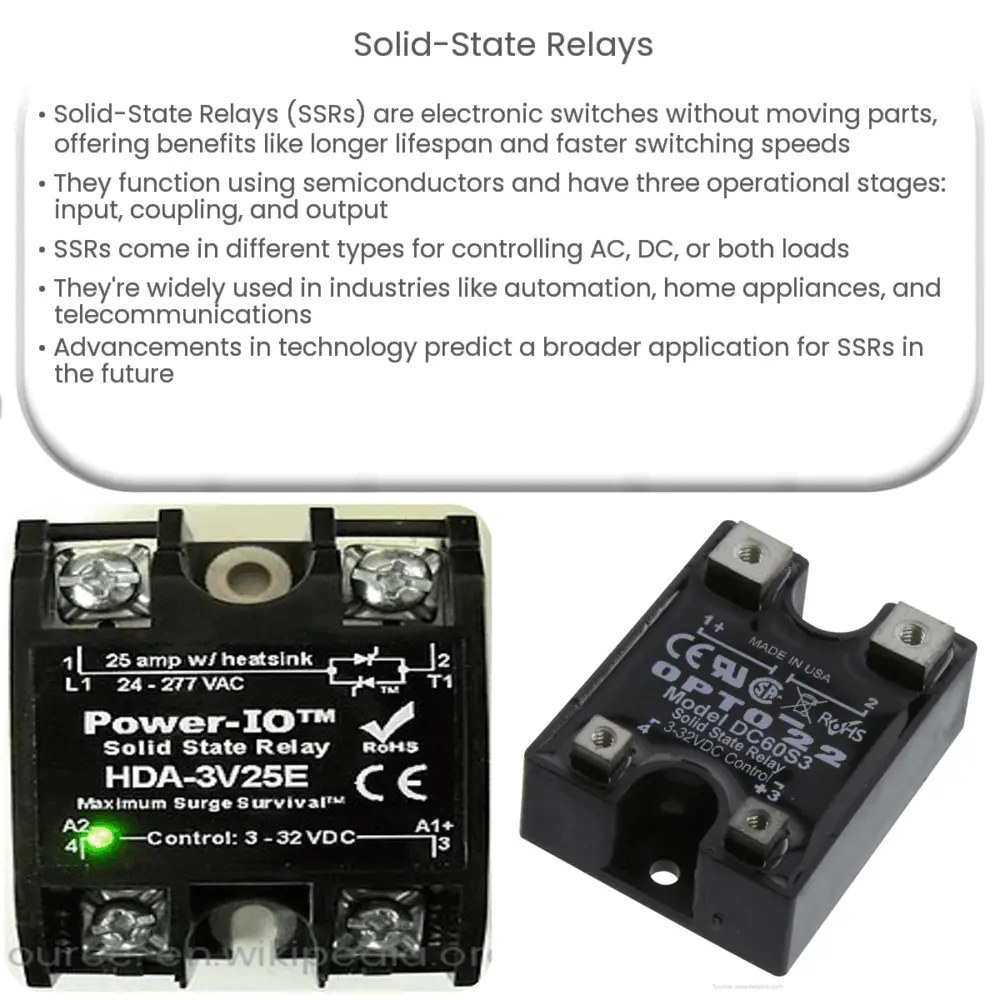Explore the world of Solid-State Relays (SSRs), their workings, types, applications, benefits, and future potential in our comprehensive guide.

Understanding Solid-State Relays (SSRs)
A Solid-State Relay (SSR) is a type of electronic switch that accomplishes switching functionality without any moving mechanical parts. SSRs have become an essential component in many modern devices, offering a range of advantages over their mechanical counterparts, including longer lifespans, faster switching speeds, and absence of noise. In this article, we delve into the workings, types, applications, and benefits of solid-state relays.
How Do Solid-State Relays Work?
SSRs function using semiconductor devices such as thyristors, triacs, diodes, and transistors. The operation of an SSR primarily involves three stages: input, coupling, and output. The input stage involves receiving a control signal, which triggers the coupling stage, often accomplished using an optical coupling method. The final output stage involves an electronic switch that controls the current flow to the load.
Different Types of Solid-State Relays
- AC Output SSRs: These are primarily used to control AC loads, usually using a zero-crossing circuit that turns on when the waveform crosses the zero-voltage point, thus minimizing electrical noise.
- DC Output SSRs: These SSRs are designed to control DC loads. They typically employ transistors to achieve this function.
- AC/DC Output SSRs: These are versatile relays capable of controlling both AC and DC loads.
Applications of Solid-State Relays
SSRs are used across a broad spectrum of applications due to their robustness and reliability. Some key areas of application include:
- Industrial Automation: In manufacturing processes, SSRs are used to control high power machinery and equipment, offering precise control and long-term reliability.
- Home Appliances: SSRs are found in many household devices such as air conditioners, ovens, and lighting systems where they offer silent operation and extended lifespan.
- Telecommunications: The telecom industry uses SSRs for switching operations in phone exchanges and data transmission equipment.
As technology continues to advance, the role of SSRs becomes increasingly prominent, offering an array of advantages over electromechanical relays. The next part of this article will delve into the distinct benefits of solid-state relays and their potential future developments.
Distinct Benefits of Solid-State Relays
SSRs offer numerous benefits that make them preferable over mechanical relays. These include:
- Long Lifespan: Due to the absence of moving parts and wear-and-tear, SSRs boast a significantly longer lifespan compared to mechanical relays.
- No Contact Bounce: As there are no physical contacts, SSRs eliminate the problem of contact bounce, ensuring a smooth and consistent operation.
- No Noise: SSRs operate silently, making them ideal for use in noise-sensitive environments.
- Fast Switching Speeds: SSRs are capable of rapid on/off switching, which is crucial for certain applications that require high-speed operation.
Future Developments and Potential of SSRs
The advancements in semiconductor technology have a direct impact on the development and performance of SSRs. As technology continues to evolve, SSRs are expected to become even more efficient, reliable, and versatile. They will likely find new applications in areas such as renewable energy, electric vehicles, and advanced automation systems, where the need for reliable, high-speed switching is paramount.
Conclusion
In summary, solid-state relays represent a significant leap from traditional mechanical relays. With their numerous benefits, such as long lifespan, no contact bounce, silent operation, and fast switching speeds, they offer more efficient and reliable solutions for a wide range of applications. From industrial automation to home appliances and telecommunications, the use of SSRs is extensive and growing.
As we look to the future, the potential of SSRs is vast, bolstered by the continuous advancements in semiconductor technology. Whether it’s in the realm of renewable energy, electric vehicles, or sophisticated automation systems, SSRs are set to play an increasingly crucial role in powering the technology of tomorrow. This testament to their design and functionality underscores the importance of understanding and harnessing the power of solid-state relays.

